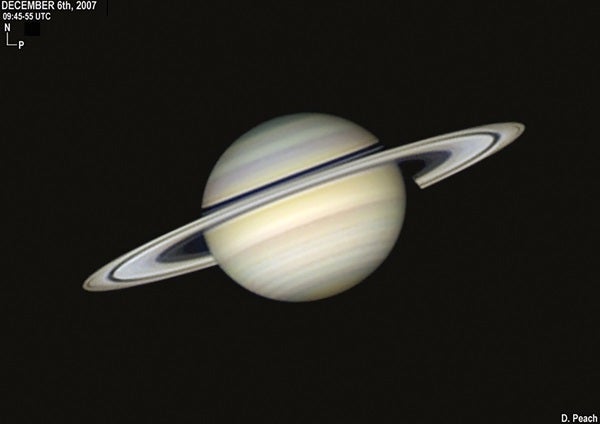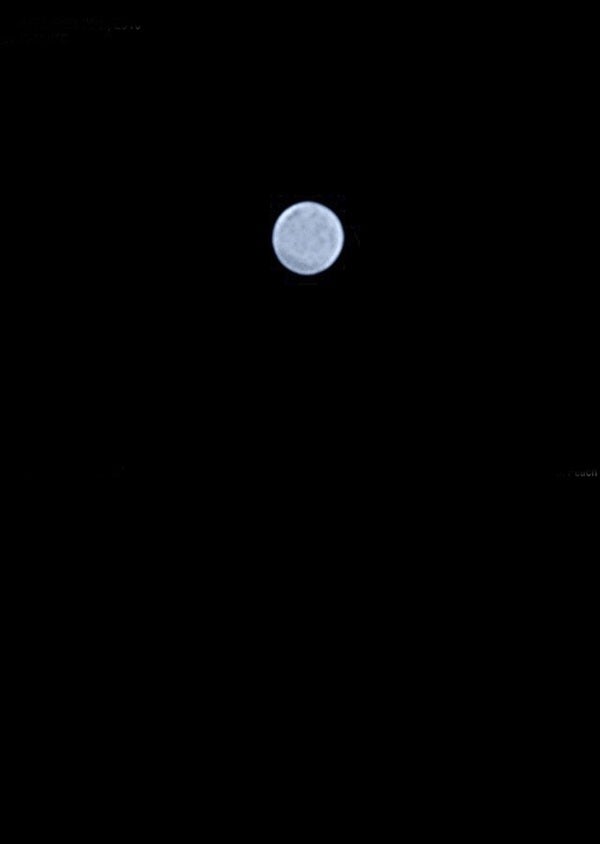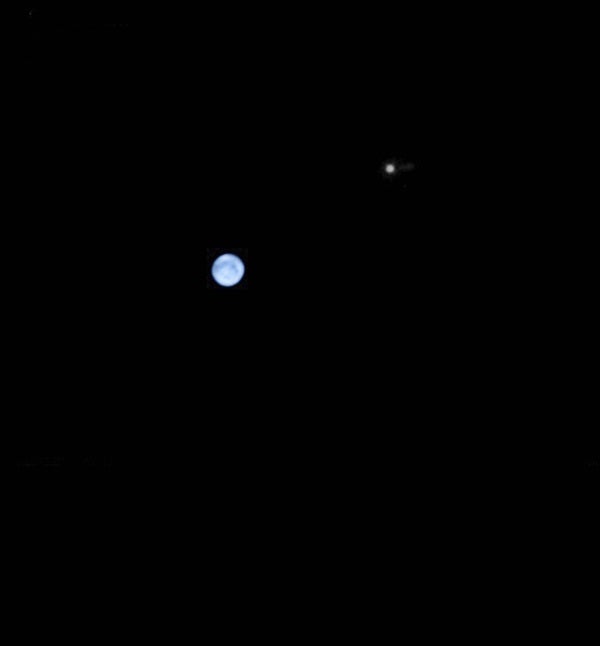Voyager 2 launched August 20, 1977, and its sister, Voyager 1, departed 16 days later. By mid-1979, both spacecraft had made close approaches to the giant of the solar system, Jupiter, and then journeyed on to worlds so distant, our minds fail to comprehend the immensity of that space. For all of us sitting back on Earth, this was an incredible time of discovery only dreamed of a few years earlier.
A few months after the Voyagers left Earth, I was working with current Astronomy Senior Editor Michael E. Bakich at a small planetarium in Lafayette, Louisiana. We delivered program after program on the Voyager mission. Schoolchildren and the public alike were thrilled with every detail of this unfolding adventure. We also ventured out every possible night to observe the targets of all this excitement: Jupiter, Saturn, Uranus, and Neptune.
Recently I rediscovered some of those memories in my observing notes and journals. An early morning rendezvous with Jupiter and Saturn, for example, on October 21, 1978, recalls that both planets were well placed in the east an hour or so before sunrise. We were observing with a 6-inch refractor mounted on an old surveyor’s tripod. My drawings show one cloud band of Jupiter as dark and a bit ragged on the upper edge with a hint of a “bulge” on the lower section. The other band was fainter, and we could see little detail on the cloud tops of Jupiter. Europa and Callisto appeared as two starlike objects. Saturn was lower in the sky, but was beautiful as always. The rings were not edge-on, but were partly closed. Unsurprisingly, we couldn’t make out any cloud details with a scope of this size.
The 6-inch refractor we used that morning in 1978 was pretty typical of the kinds of scopes many amateurs used in the 1960s, ’70s, ’80s, and beyond. Browse through the ads of any astronomy magazine of the time, and you will see ads for the Criterion Dynascope RV-6 reflector, Unitron 2.4- and 3-inch reflectors, and the orange squat tube of an 8-inch Celestron telescope.
Resetting the solar system
What we didn’t appreciate fully quite yet, in 1978, was that all of us who were into amateur astronomy were about to have our proverbial socks blown off as Voyager 1 made its close approach to Jupiter in March 1979 and Voyager 2 in July of the same year. The astounding detail of the images returned by these spacecraft forced us to totally rethink not only what we knew about this giant planet, but the solar system as a whole.
In the early years of my planetarium career, I used astronomy books written by Isaac Asimov as an authoritative source for school and public programs. One of those was Jupiter, The Largest Planet. According to Asimov, Jupiter had 13 moons. The Voyagers added three more moons to the realm of Jupiter. Today we count 51 moons with names, and another 18 that orbit anonymously around the giant planet.
Planetary discoveries were happening even before the spacecraft departed. On March 10, 1977, just months before the Voyagers launched, the world learned that Uranus, like Saturn, has a system of rings. MIT astronomer Jim Elliott made the discovery while watching Uranus occult, or pass in front of, a star, to study the planet’s atmosphere and other features. To his surprise, the star faded in and out before it disappeared behind the planet, providing evidence for the rings. Then, in 1979, Voyager 1 revealed that the king of planets, Jupiter, is also surrounded by four thin dust rings.
Flipping through my observing journals, I came across an unusual night several years later, on July 17, 1985. I was observing both Jupiter and Saturn. The Voyager rendezvous with these two gas giants was over, and Voyager 1 was on its way out to the edge of the solar system. That night, I was using a Celestron 8-inch telescope and a range of eyepieces. At about 250x, both planets held up well with clear details. I could see at least five bands on Jupiter and the shadow of the moon Io as it progressed across the disk of Jupiter.
Saturn was gorgeous, as always. My drawing shows the rings almost wide open. I noted one cloud band and the Cassini Division as quite clearly visible. As I watched Saturn drift by in my field of view, I thought of all we had learned about the ringed planet during the past few years. In the C8, I could easily see features that had been observed for the past three centuries. Now we knew that Saturn’s rings were far more complex than what any ground-based telescope could show. In the high-resolution images returned by Voyager 2, astronomers discovered hundreds of thin rings, some only a few feet thick.
Imaging the outer planets
I have always enjoyed drawing what I see in the eyepiece. Many of my contemporaries, however, have produced images of the outer planets using backyard scopes and cameras.
For many years, my go-to book on astrophotography was Outer Space Photography for the Amateur by Henry E. Paul, published in 1960. The book still provides a gold mine of information, covering everything from lenses and telescopes to home observatories and sky conditions. Paul recommends using a standard 6-inch f/8 reflector or a 3-inch f/15 refractor, with a preference for the reflector. Obviously, a telescope needs a motor drive to compensate for Earth’s rotation. But the revolution in CCD imaging and the use of digital cameras has made the techniques described in this book obsolete. Even films recommended by Paul, such as Kodak’s High Contrast Copy Film and Plus-X, have long become extinct.
In the 1980s, Voyager 2 undertook flybys of Uranus and Neptune, the ice giant planets. My ever-present notebook has an entry for June 9, 1981, featuring an evening search for Uranus. I was using a 41/4-inch rich field telescope, a sheet from Atlas of the Heavens, and a finder chart from the Abrams Planetarium Sky Calendar. It was easy to spot Uranus’ blue-green disk among a number of stars that formed a loose triangle with 41 and Kappa Librae. Needless to say, Uranus appeared as only another bright “star” among this fairly bright group. Even with my 3-inch Unitron and Celestron 8, I could never see any details on this planet. Both Paul’s book and the Jupiter book by Asimov have photographs of Uranus and Neptune made with large ground-based telescopes. Because of atmospheric turbulence, no details can be seen in these photos — just a bright, blurry disk with a few of its moons present.
Sharing the excitement of Voyager
By the end of Voyager’s Grand Tour, in August 1989, I was director of the Flandrau Planetarium at the University of Arizona, and an excited participant on a television panel of experts talking about Voyager 2’s recent close encounter with Neptune. On August 24, Voyager made its closest approach to this distant, shimmering, blue ice giant.
Sitting next to me was Carolyn Porco, a key member of Voyager’s imaging team. I felt out of place among the professional astronomers from the university and their years of experience and knowledge they represented. I was, however, the only one at this KUAT public television event who observed the sky with small telescopes and regularly brought these exciting events to the public through planetarium shows.
One of the most exciting discoveries discussed was the existence of massive storms in the upper atmosphere of Neptune. Since the planet is nearly 3 billion miles from the Sun, it was assumed that it’d be far too cold to have any kind of weather. Passing just 3,000 miles (4,800 kilometers) above the planet’s cloud tops, Voyager 2 discovered what was dubbed the Great Dark Spot. Voyager also added six new moons, recorded the fastest winds on any planet in the solar system, and uncovered a set of planetary rings.
When the moderator, John McClury, turned to me and asked, “Can the average amateur astronomer expect to see any of these new discoveries in their telescopes?” I had to answer, “None of it.” These discoveries are truly beyond not only any amateur equipment, but also the greatest telescopes on Earth. “You may not be able to see these discoveries for yourself, but knowing about them makes your own observations so much more interesting,” I said.
Thinking about what the Voyager mission meant to astronomy enthusiasts, I found another old notebook entry. This one was from August 19, 1976. I was observing with the 24-inch Ritchey-Chrétien telescope at Michigan State University with Dave Duzinski, a fellow grad student. We had been taking photographs of Jupiter. After we were done and Dave had gone into the darkroom, I had the scope to myself and began observing the planet visually.
A unique and epic voyage
All these memories and musings have brought me back to Carl Sagan’s book Cosmos, published in 1980. The chapter “Travelers’ Tales” compares the adventures of the newly launched Voyagers to the early discoveries of the 18th century.
“This is the time when humans have begun to sail the sea of space,” Sagan writes. “The modern ships that ply the Keplerian trajectories to the planets are unmanned. They are beautifully constructed semi-intelligent robots exploring unknown worlds. . . . We have embarked on epic voyages.”
Not only was our understanding of these outer worlds about to change forever, but so was the view in our modest telescopes.













